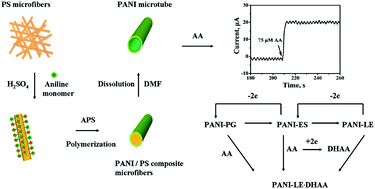Diameter-controlled synthesis of polyaniline microtubes and their electrocatalytic oxidation of ascorbic acid†
Abstract
An easy and convenient method for the synthesis of polyaniline (PANI) microtubes was developed using polystyrene (PS) electrospun microfibers as a template. The diameter range of these microtubes was from 0.63 to 2.93 μm. This accuracy was achieved by tuning the template microfiber's diameter. Cyclic voltammetry (CV) and electrochemical impedance spectroscopy (EIS) were used to study the effect of these microtubes' diameters on their electroactivity. When the diameter is 1.43 μm, the PANI microtube exhibited the maximum electroactivity and a distinguished electrocatalytic oxidation of ascorbic acid (AA). Herein, the PANI microtube was fabricated into an amperometric AA sensor. At the working potential of 0.4 V (vs. SCE), the oxidation current was significantly enhanced by the addition of a low concentration of AA but no such current was observed with other selected small molecules. The AA detection limit was 0.28 μM at the signal-to-noise ratio of 3. A linear relationship was demonstrated between the oxidation current enhancement and the AA concentration ranging from 5.0 μM to 4.7 mM. The detection limit was better than a reported PANI nanotube (1.0 μM), nanofiber (1.7 μM) and nanoparticle (8.3 μM). The high sensitivity could be attributed to the PANI microtube's high conductivity, high electroactivity for the AA electrocatalytic oxidation, as well as its high surface-to-volume ratio resulting in an efficient interaction between the microtube and the AA molecule. A promising application of the PANI microtube-based sensor was offered.


 Please wait while we load your content...
Please wait while we load your content...